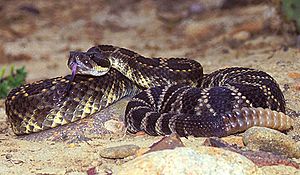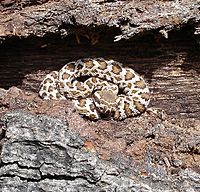Southern Pacific rattlesnake facts for kids
Quick facts for kids Southern Pacific rattlesnake |
|
|---|---|
 |
|
| Scientific classification | |
| Genus: |
Crotalus
|
| Species: |
helleri
|
| Synonyms | |
|
|
The Southern Pacific rattlesnake, known scientifically as Crotalus helleri, is a type of highly venomous snake. It is a pit viper, which means it has special heat-sensing pits on its face. These snakes live in southwestern California in the United States and stretch south into Baja California, Mexico.
Contents
What's in a Name?
The scientific name for this snake, helleri, was given in honor of Edmund Heller. He was an American zoologist, a scientist who studies animals.
Meet the Southern Pacific Rattlesnake
Adult Southern Pacific rattlesnakes usually grow to be about 24 to 55 inches (61 to 139 centimeters) long.
Their skin color can be pale brown, gray-brown, or yellowish-brown. They have large, dark brown blotches on their backs. These blotches often look like diamonds and might have lighter centers. They are outlined by lighter scales.
When they are young, the end of their tail is a bright orange color. As they get older, this orange fades to brown. The base of their tail and the first part of their rattle are brown in adult snakes. They also have a dark stripe behind their eyes. In young snakes, a pale stripe borders this dark stripe. This pale stripe turns dull yellow or brown as they grow up.
Other Names for This Snake
People call the Southern Pacific rattlesnake by several other names. Some of these include the black diamond rattlesnake, black rattler, gray diamond-back, mountain rattler, Pacific rattler, and San Diegan rattler.
Understanding Its Venom
The venom of the Southern Pacific rattlesnake is very strong. It is similar to a type of venom called Mojave toxin. This venom mainly affects the nervous system, which controls your body's functions. It also contains toxins that can harm muscles (myotoxins) and blood (hemotoxins). Because of these powerful toxins, a bite from this snake can be very dangerous.
If someone is bitten by this snake, they would need a special medicine called antivenom. For this snake's venom, a larger amount of antivenom, like "Crofab," is often needed compared to other rattlesnake bites.
Where These Snakes Live
You can find the Southern Pacific rattlesnake in the southern parts of California, USA. This includes counties like San Luis Obispo, Kern, Santa Barbara, Ventura, Los Angeles (even Santa Catalina Island), San Bernardino, Orange, Riverside, San Diego, and Imperial.
Their range also extends south into northern Baja California, Mexico, but mostly west of the desert areas.



